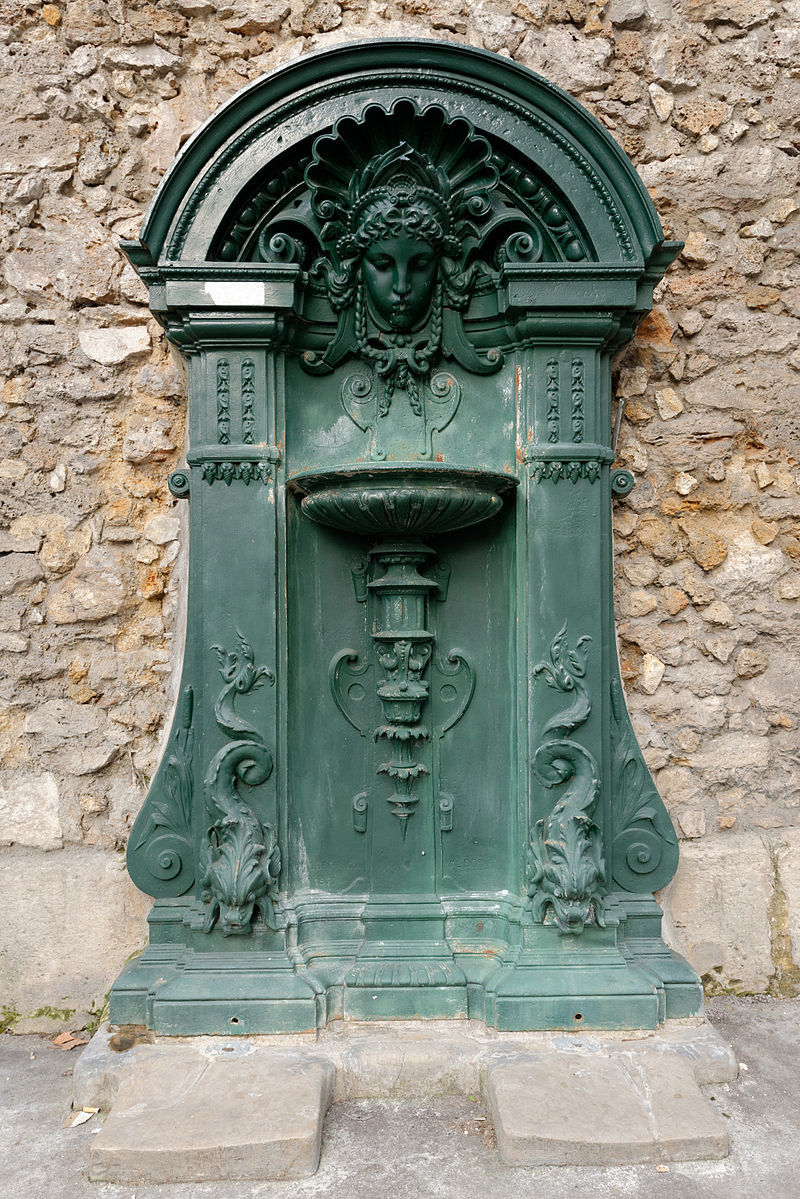Art is Everywhere in Paris

The city of Paris is serious about keeping their city clean. In an effort to reduce litter and plastic use, you can find numerous water dispensers throughout the city; even sparkling water dispensers. They’re extremely popular and used regularly by locals and tourists alike. But, public water fountains aren’t a new thing in Paris.
Fresh water has been made available for citizens in Paris since the late 1800’s. These original public drinking fountains, Wallace fountains, are literally small iron sculptures and are scattered around Paris on the busier sidewalks.

In the 1800’s litter wasn’t the primary concern; it was access to clean water for everyone, not only the wealthy. Aqueducts, from Roman times in the third century until the early 20th century, aqueducts supplied Paris with clean water. Believe it or not, an aqueduct (built in the 15th century along the line of an original Gallo-Roman aqueduct) still transports water to a lake in the Montsours park in the south of Paris.
Clean Water for All
Clean water became a real luxury in 1871. Paris’s aqueducts and, thereby easy access to clean water, were destroyed during the Franco-Prussian war (1870-1871). Consequently, the price of clean water rose dramatically which spurred the development of a ‘black-market’ for water. Unscrupulous business people would syphon water from the Seine, into which sewers drained, and bottle for sale. For the poor not able to afford the safe, clean water, it was safer to purchase beer and wine.
Sir Richard Wallace was a wealthy English art collector and philanthropist who lived in France. His solution to this problem was the erection of public drinking fountains. So, adhering to several strict guidelines, Sir Wallace set out to design the fountains himself.
- Height: They had to be tall enough to be seen from afar but not so tall as to destroy the harmony of the surrounding landscape.
- Form: Both practical to use and pleasing to the eye.
- Price: Affordable enough to allow the installation of dozens.
- Materials: Resistant to the elements, easy to shape, and simple to maintain.
Wallace sketched out two different models varying in height and design. He then contacted a sculptor he knew, Charles-Auguste Lebourg, to produce them and funded the project. Lebourg refined Wallace’s designs and created 50 fountains in cast iron, which was inexpensive, easy to mold, and durable. The city government specified the fountains to be painted dark green in order to blend in with the parks and tree-lined avenues. The first fountain was installed on Boulevard de la Villette in the 19th arrondissement in 1875.

The city installed the remaining 49 originals around Paris. Years later, an additional 50+ were produced in similar designs and installed on busy sidewalks.
Today, the fountains that remain continue to be a source for clean water, at least between March 15 and November 15. Not only do the fountains benefit the poor and/or homeless, locals and tourists alike use the fountains regularly, filling up cups or travel canteens as they pass by. The water is tested by the city regularly and the fountains are repainted every 2 years, most the original British green color. The local counsel in the 13th arrondissement had a few of theirs “individualized”, to bring more attention to the fountains and to the 13th arrondissement.

Typical Paris, right? Even public water fountains are works of art.
For a comprehensive list, description and photographs, click on this link http://www.fontaine-wallace.info/ If you’d like to read more about Wallace, an interesting character, go here.

I love this! While they aren’t beautiful, we were delighted that so many public fountains in St. Augustine are constructed so that bottles can be filled. So cool. Sir Richard Wallace gets a huge thank you for these fountains. So cool